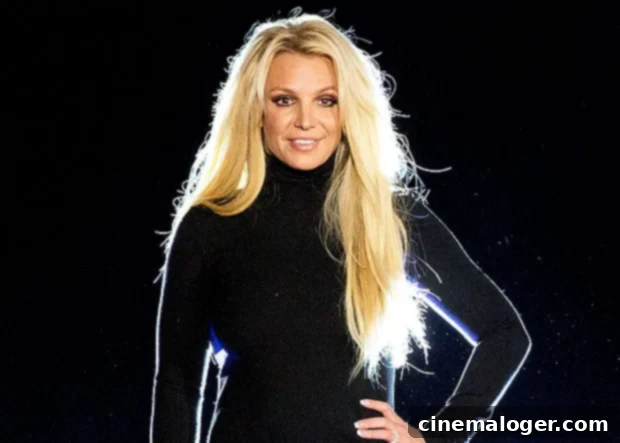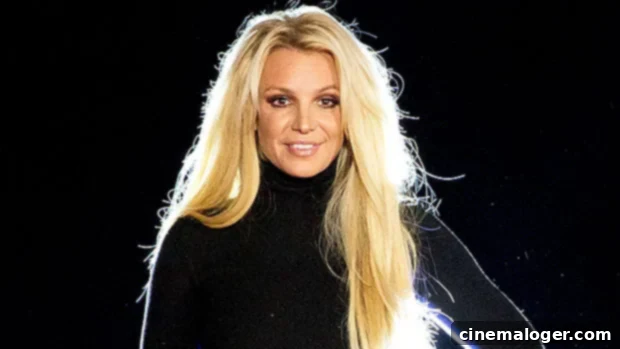Britney Spears’ Bold Transformation: A New Haircut Ignites Deeper Conversations About Freedom and Conservatorship
Pop icon Britney Spears recently captivated her millions of fans by showcasing a dramatic new look – a self-administered haircut that signals more than just a change in style. On December 16, the Grammy-winning singer took to Instagram to reveal she had personally chopped her signature long blonde locks into a chic, shoulder-length lob (long bob), complete with stylish side bangs. This spontaneous act of self-expression quickly garnered attention, with her caption, “Cut my hair !!!! You know what they say …. out with the old …. in with the new !!!!! Now let us pray !!!!”, resonating deeply with her followers and hinting at a desire for profound change. In the accompanying selfie, Britney exuded confidence, pouting at the camera, her eyes accentuated by heavy black eyeliner, while sporting a vibrant floral-printed top. The post immediately sparked a flurry of reactions, transforming a simple haircut into a significant talking point amidst her ongoing, highly public conservatorship battle.
The act of cutting one’s own hair, often a symbol of reclaiming personal agency and undergoing a significant life transition, takes on an even greater meaning for Britney Spears. In a career defined by intense public scrutiny and a carefully managed image, a DIY haircut represents an intimate, unscripted moment of control. This isn’t merely about aesthetics; it’s a powerful statement of autonomy. For years, discussions around Britney’s life have revolved around her conservatorship, which has governed her personal and financial affairs since 2008. In this context, even a seemingly small decision like a haircut can be interpreted as an assertion of her independence and a visual manifestation of her desire to “cast out the old” and embrace a “new” phase of her life. The bold, shorter style highlights her face and seems to embody a fresh, defiant spirit that many fans have long hoped to see.
View this post on InstagramA post shared by Britney Spears (@britneyspears)
Fan Reactions and the #FreeBritney Movement’s Echoes
The comments section of Britney’s Instagram post quickly became a microcosm of the public’s complex relationship with the star. Many fans poured out enthusiastic support, with comments like “THIS IS SO CHIC WOWW” and “YESSSSSSSS love the hair and the new floral” flooding in. These reactions highlight the enduring adoration for Britney and her ability to inspire and entertain. However, not all feedback was purely celebratory. Some followers expressed concern, noting that Britney didn’t “look well,” a sentiment that often arises within the context of the ongoing #FreeBritney movement. This movement, initiated by fans who believe Britney is being unjustly controlled by her conservatorship, vigilantly monitors her social media for signs of distress or coded messages.
The divided reaction underscores the heightened sensitivity surrounding Britney’s public persona. For dedicated followers of the #FreeBritney movement, every public appearance, every social media post, and every personal decision, no matter how small, is analyzed for deeper meaning. The new haircut, while a seemingly simple personal choice, is interpreted by some as either a positive step towards reclaiming her life or, conversely, as a potential indicator of internal struggle if it seems out of character or accompanied by expressions that suggest unease. This deep level of engagement from her fanbase reflects not only their loyalty but also their genuine concern for her well-being and autonomy. The discussion isn’t just about a haircut; it’s about the broader narrative of a beloved figure seeking control over her own destiny.
Jamie Spears Breaks Silence Amid Legal Turmoil
The timing of Britney’s haircut reveal coincided with significant developments in her conservatorship case. Just one day prior to her Instagram post, her father, Jamie Spears, spoke out for the first time since Britney formally requested his removal as her conservator. In an exclusive interview with CNN, Jamie, 68, asserted that he had been on “good terms” with his superstar daughter until August of that year. This was when her attorney, Samuel D. Ingham III, filed a petition to officially terminate Jamie’s involvement in her conservatorship, escalating what had been a simmering legal dispute into a full-blown public battle.
Jamie Spears used the platform to express his profound sentiments, stating, “I love my daughter and I miss her very much.” He elaborated on his perceived role, emphasizing the protective measures he believes he has provided for over a decade: “When a family member needs special care and protection, families need to step up, as I have done for the last 12-plus years, to safeguard, protect and continue to love Britney unconditionally. I have and will continue to provide unwavering love and fierce protection against those with self-serving interests and those who seek to harm her or my family.” His statement painted a picture of a loving, concerned father acting in his daughter’s best interests, portraying himself as a shield against external threats and a steadfast guardian of her welfare.

The Conservatorship: A Decade of Control and Rising Tensions
The conservatorship, established in 2008 following Britney’s highly publicized mental health struggles, initially placed her entire estate under her father’s control. What began as a temporary measure designed to provide stability during a vulnerable period eventually evolved into a long-term legal arrangement, granting Jamie Spears significant authority over Britney’s personal life, career decisions, and her substantial $60 million fortune. For years, the details of this arrangement largely remained out of the public eye, but recent court filings and growing fan activism have thrust it into the spotlight, igniting a fierce debate about individual liberties and the complexities of conservatorship law.
Britney’s attorney, Samuel D. Ingham III, has presented a starkly different narrative in court. In his legal filings, Ingham alleged that the “Toxic” singer was, in fact, “afraid” of her father. These allegations paint a troubling picture of a relationship characterized by fear and a lack of trust, directly contradicting Jamie’s claims of unconditional love and protection. Furthermore, Ingham contended that Jamie made crucial business decisions regarding Britney’s career and finances without her knowledge or consent. This specific point is particularly significant as it strikes at the heart of autonomy and the legal obligations of a conservator to act transparently and in the ward’s best interest. The implication is that Britney’s voice and wishes were being systematically sidelined, leading to a profound sense of disempowerment.
Perhaps the most potent revelation from the court documents was the assertion that Britney would not perform again as long as her father remained at the helm of her conservatorship. This stance represents a critical turning point. For a pop superstar whose career has been her identity and primary source of income, refusing to perform is an ultimate act of protest, leveraging her professional power to demand personal freedom. It signals her unwavering resolve to regain control over her life and career, transforming the legal battle from a quiet court proceeding into a high-stakes public spectacle. This refusal to work under her father’s supervision highlights the depth of her desire to remove him from his position and re-establish her independence.
The Broader Implications: Autonomy, Mental Health, and Legal Reform
The Britney Spears conservatorship case has transcended the typical celebrity drama, evolving into a significant discourse on mental health awareness, individual rights, and the ethical implications of conservatorship laws. The #FreeBritney movement has been instrumental in raising public consciousness, drawing attention to the potential for abuse within such legal frameworks, particularly when they involve individuals who appear capable of managing their own affairs. Fans and legal experts alike question how a person deemed capable enough to headline lucrative Las Vegas residencies, release albums, and maintain a rigorous public schedule can simultaneously be deemed incapable of making personal and financial decisions.
This case forces a re-examination of the balance between protection and control. While conservatorships are designed to safeguard vulnerable individuals, especially those with severe cognitive impairments, the long-standing nature of Britney’s conservatorship, combined with her continued professional productivity, raises critical questions about its necessity and scope. The legal proceedings are not just about Britney’s personal freedom; they also shine a spotlight on the broader need for transparency and accountability within the legal system to prevent potential exploitation or undue influence over individuals deemed to be under “special care.” The global attention on her fight is pushing for a wider conversation about human rights and legal reforms for those under similar arrangements.
A Symbol of Hope and Resilience
In this complex narrative of legal struggle and personal transformation, Britney Spears’ new haircut emerges as more than just a fleeting style choice. It is a potent symbol of change, a visual declaration of her desire for a fresh start, and an assertion of autonomy in a life that has largely been dictated by others. As the legal battle continues to unfold, with her attorney steadfastly fighting for Jamie Spears’ removal and Britney refusing to perform until her demands are met, the world watches. Her bold new look, coupled with her public statements and actions through her legal team, reinforces a powerful message: Britney Spears is actively fighting to reclaim her narrative, her freedom, and ultimately, her life. The journey from “old” to “new” is not just about her hair; it’s about a pop icon striving for self-determination against formidable odds.
